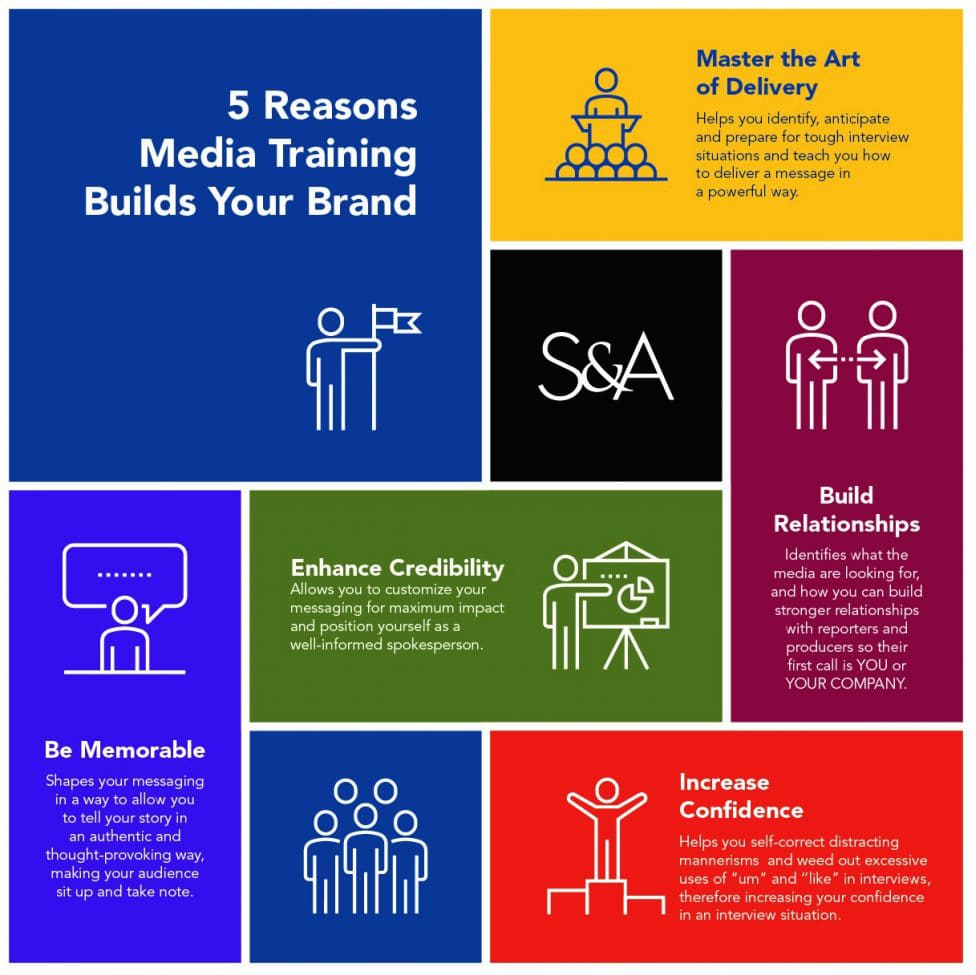5 ways media training maximizes your brand
by S&A Staff

The biggest fears we hear from our clients about media interviews include:
- What if I’m misquoted?
- What happens if I’m asked a tough question and don’t know the answer?
- What can I say that won’t get me in trouble with our legal and regulatory departments?
These are valid concerns and knowing how to control an interview while working within the parameters of your legal and regulatory bodies is a key part of media training. You will get to know the common pitfalls in media interviews and the right strategies to overcome them, particularly when experiencing a high-pressure interview.
Media training not only prepares you for confident interactions with the media, but it also gives you useful techniques when presenting to boards, as well as communicating with internal staff, stakeholders and investors. Most important, you understand the benefits of utilizing the media to convey your messages.
Here are five ways media training can build your brand:
1. Master the art of delivery
In today’s media-savvy society, company spokespeople have only one chance to make a good first impression. Media training is vital because your professional reputation and brand messaging are on the line. Spokesperson training can teach you how to use words, tone and body language to deliver a message in a powerful way – we call it “multidimensional communications.”
Journalists will likely toss in a few questions that you are not expecting. Media training can help you think like a journalist. By helping identify, anticipate and prepare for tough interview questions your spokesperson will be more relaxed and exude more confidence. These are great qualities that leave a lasting impression and help you become a sought-after resource.
2. Be memorable
Journalists are constantly looking for interesting and engaging stories to develop for viewers and listeners. What most people don’t know is that for every article that gets published or aired, there could be at least two or three others that hit the cutting-room floor. That’s why you need to position yourself and your brand in a powerful way that encourages people (and reporters) take notice.
We believe the critical element is connection. Connecting to your material and your audience is everything. Journalists are not interested in canned stories or “marketing speak,” which offers little value and insight for their audiences.
Taking time to really understand your business and communication style is important. Once this is established, it will help shape your messaging to allow you to tell your story in an authentic and thought-provoking way, making your audience sit up and take note. We believe words matter, and how they are used matters even more. This is a cornerstone principal of Stephens & Associates’ public relations, content development and spokesperson training services.
3. Enhance credibility
Media outlets want a spokesperson who is a dynamic, trusted source of information. In today’s media environment, journalists are asked to do more with fewer resources, often having limited time for fact gathering and investigation. As a result, journalists are turning more and more to trusted public relations professionals and the companies they represent for content and story ideas.
Media training helps you to determine the best way to get your message across in a trusted and compelling manner. By teaching you how to analyze your audience and understand their level of knowledge and interest in the topic, we can help you customize your messaging for maximum impact and credibility.
4. Increase confidence
Media interviews can be very daunting. However, media training can help develop or even enhance your interview skills, and you will find speaking to the media gets easier with each interaction. Using mock interviews, we can help you self-correct distracting mannerisms and weed out excessive uses of “um” and “like,” therefore increasing your confidence before, during and after the interview.
5. Build relationships
We cannot stress enough the value of building media relationships and how media training can assist in understanding how to form and cultivate those bonds. Almost everything we do in public relations centers on interacting with the media and our job is to help make sure you get their attention. Media training can help you identify what the media are looking for, and how you can build stronger relationships with reporters and producers so their first call for a news story is YOU or YOUR COMPANY.

The media landscape is constantly changing, especially in the social media world. Everyone you meet is a potential reporter. Nowadays, with every interaction – online or offline – your message can be broadcast around the world within seconds. Media training could be the most important investment you make.
And with the recent rise in “fake news,” professionals such as ourselves must be even more diligent in helping to shape the type of news and information being delivered through the media.
At Stephens & Associates, we help start-ups and long-established brands interface with the public, and we’ve done so for almost 40 years. Media training is a powerful exercise we offer our clients to give them a leg up on their competition.

